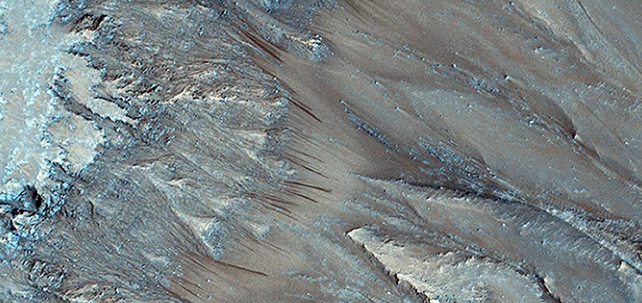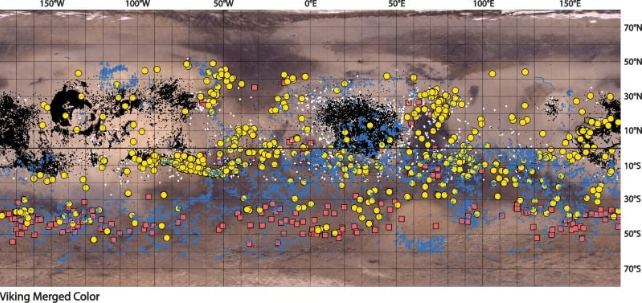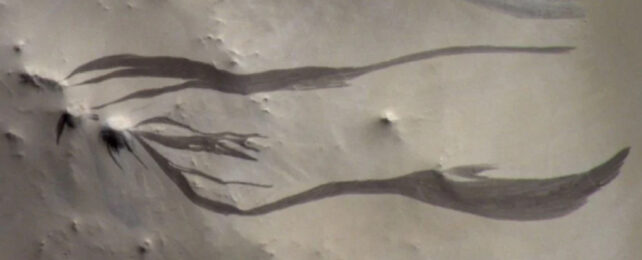It was big news years ago when Mars orbiters found streaks of what appeared to be water running down Martian cliffs and crater walls. Scientists worked hard to figure out what they were. Some proposed that they were seasonal streaks of briny ice, melting as the weak Mars summer arrived.
New research says no to that.
Our understanding of Mars, its past, and its ancient habitability hinges on our understanding of its water. The planet is cold and dry now, but was warm and wet in its past. One of the critical questions concerns what happened to its oceans' worth of water.
When scientists started finding dark streaks on the Martian surface that looked like they could be seasonal water flows, it generated quite a bit of excitement.
Could this be the remnants of Mars' ancient water, seeping onto the surface from where it's sequestered underground? Could this underground reservoir provide habitat for simple life?

The streaks were named recurring slope lineae (RSL). They appear and reappear in the same places and can extend for hundreds of meters down slopes.
New research in Nature Communications examined the issue and concluded that RSL and other streaks are not water-related. It's titled "Streaks on martian slopes are dry," and the authors are Valentin Bickel and Adomas Valantinas. Bickel is from the Center for Space and Habitability at the University of Bern in Switzerland, and Valantinas is from the Department of Earth, Environmental and Planetary Sciences at Brown University.
The research is focused on two related phenomena: RSL, which appear and disappear seasonally, and slope streaks, which can take years to fade.
"Slope streaks are dark albedo features on Martian slopes that form spontaneously and fade over years to decades," the researchers write.
"Along with seasonally recurring slope lineae, streak formation has been attributed to aqueous processes, implying the presence of transient yet substantial amounts of liquid water or brines on Mars' surface, with important implications for present-day Mars' habitability."
Previous research has identified many potential explanations for streaks and RSL. Ground springs of briny water, seasonal melt of briny ice, impact Marsquakes, and wind have all been proposed. Researchers have found that while RSL occur predominantly in the southern summer, streak formation is enhanced in the northern autumn and winter.
"To date, it remains unclear whether slope streaks and RSL are different expressions of the same process, or fundamentally different features," the authors write.
Understanding these features correctly has consequences. If they have a wet formation mechanism, the planet has a more pronounced hydrological cycle than previously thought. That would affect our understanding of Mars' climate, weather, surface evolution, and potential habitability.
We'll also have to be much more cautious about exploring Mars. "In addition, liquid water or brines on Mars' surface would evoke serious concerns about planetary protection," the authors point out.
To understand these streaks, the researchers created a catalogue of 500,000 of them. They found a total of 13,026 bright and 484,019 dark slope streaks. They display various morphologies and are both 'light' and 'dark' streaks.
There's no absolutely clear delineation between bright and dark, but dark streaks are younger and appeared more recently, while light streaks are older.
"Once we had this global map, we could compare it to databases and catalogs of other things like temperature, wind speed, hydration, rock slide activity and other factors," Bickel said.
"Then we could look for correlations over hundreds of thousands of cases to better understand the conditions under which these features form."
After examining the data, the researchers reached some conclusions. "Our observations discard three previously proposed dry streak formation mechanisms: dust devils, rockfalls, and thermal cycling do not appear to play a globally important role in triggering slope streaks," they write.

They also found that their observations didn't support any wet-formation scenarios either. Streaks don't favour any particular slope orientation, challenging the idea that CO2 frost is a trigger.
However, dry formation scenarios are supported. "We identify three global-scale, statistically significant relations that support dry formation hypotheses for slope streaks," the authors write.
Streak populations are located slightly closer to new impacts, experience above-average surface wind velocities, and also experience above-average dust deposition rates in the northern winter, which coincides with their enhanced seasonal formation.
"A big focus of Mars research is understanding modern-day processes on Mars – including the possibility of liquid water on the surface," said lead author Valantinas in a press release.
"Our study reviewed these features but found no evidence of water. Our model favors dry formation processes."

"Our findings suggest that martian slopes currently do not experience seasonal, transient flows of liquid water or brines, underscoring the dry, desert-like nature of Mars," the researchers write in their conclusion. This alleviates one of the concerns about exploring regions where streaks and RSL appear. If they're wet, the potential for inadvertent contamination by Earth life has to be taken seriously. If they're dry, there's much less concern.
"This implies that slope streak and RSL locations are not likely to be habitable, alleviating strict planetary protection measures for future landed missions to those regions," the authors conclude.
"That's the advantage of this big data approach," Valantinas said. "It helps us to rule out some hypotheses from orbit before we send spacecraft to explore."
This article was originally published by Universe Today. Read the original article.
